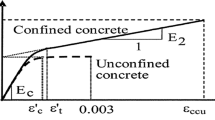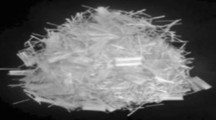Abstract
Our study was directed to improve the residual flexural strength and the heat-resistant properties of concrete exposed to high temperatures using different fiber cocktail loadings including steel, polymer or cellulose fibers. At first the morphology and the thermal properties of the fibers and the fiber/cement composites were investigated by SEM and TG/DTA-MS. Then the influence of fiber type and amount on residual flexural strength was tested after cooling back from 150, 500 or 800 °C temperature loadings. By adding steel, cellulose and polymer (polypropylene) fibers to cement, improvements both in post-cracking residual flexural strength and in insensitivity against explosive spalling were reached.










Similar content being viewed by others
References
Allison R. Inquiry into the fire on heavy goods vehicle shuttle 7539 on 18 November 1996. London: HMSO; 1997.
Fellinger J, Breunese A. Fire safe design: make it concrete!. In: Gambarova PG, Felicetti R, Meda A, Riva P, editors. Fire design of concrete structures: What now? What next? Proceedings of workshop. Brescia: Starrylink Editrice Brescia; 2015. p. 313–316.
Lublóy É, Czoboly O, Hlavička V, Oros ZS, Balázs GL. Experiences of the fire case of athletic hall of the University of Physical Education in Budapest 15 Oct. 2015. Vasbetonépítés. 2015;3:50–5.
Lublóy É, Kopecskó K, Balázs GL, et al. J Therm Anal Calorim. 2016;. doi:10.1007/s10973-016-5392-z.
Balázs GL, Lublóy É. Fire resistance for thin-webbed concrete and masonry elements. In: Applications of Structural Fire Engineering: Proceedings of the International Conference in Dubrovnik. 2015. p. 1–6.
Thielen KC. Strength and deformation of concrete subjected to high temperature and biaxial stress-test and modelling. Book 437. Berlin: Deutscher Ausschuss für Stahlbeton; 1994.
Noumowe A. Mechanical properties and microstructure of high strength concrete containing polypropylene fibres exposed to temperatures up to 200 °C. Cem Concr Res. 2005;35:2192–8.
Chan SYN, Luo X, Sun W. Effect of high temperature and cooling regimes on the compressive strength and pore properties of high performance concrete. Constr Build Mater. 2000;14:261–6.
Chan YN, Luo X, Sun W. Compressive strength and pore structure of high-performance concrete after exposure to high temperature up to 800 °C. Cem Concr Res. 2000;30:247–51.
Peng GF, Yang WW, Zhao J, Liu YF, Bian SH, Zhao LH. Explosive spalling and residual mechanical properties of fiber-toughened high-performance concrete subjected to high temperatures. Cem Concr Res. 2006;36:723–7.
Aßbrock O, Carlswärd J, Dietze R, Guirguis P, Hemrich W, Lambrechts A, Löfgren I, Schulz M, Troy J, Gibbs J, Harrison T, Ressler C. Guidance to fibre concrete. Properties specification and practice in Europe. European Ready Mixed Concrete Organization: Bruxelles; 2012. p. 1–39.
Rossino C, Monte FL, Cangiano S, Felicetti R, Gambarova PG. Concrete spalling sensitivity versus microstructure: preliminary results on the effect of polypropylene fibers. MATEC Web Conf. 2013;6:1–9.
Rossino C, Monte FL, Cangiano S, Felicetti R, Gambarova PG. HPC subjected to high temperature: a study on intrinsic and mechanical damage. Key Eng Mater. 2014;629–630:239–44.
Lublóy É. Effect of fire to the concrete structures. Ph.D. dissertation. Budapest. 2008.
Fib bulletin 46. Fire design of concrete structures—structural behaviour and assessment. State-of-art report. TG 4.3. Ostfildern: DCC Document Competence Center Siegmar Kästl e.K; 2008.
Luda MP, Dall’Anese R. On the microstructure of polypropylenes by pyrolysis GC-MS. Polym Degrad Stab. 2014;110:35–43.
Endo K, Kobayashi N, Aida M, Hoshi T. Spectral analysis of polystyrene. Polypropylene, and Poly(methyl methacrylate) Polymers in TOF SIMS and XPS by MO calculations using the model oligomers. Polym J. 1996;28:901–10.
Evans RJ, Milne TA, Soltys MN. Mass spectrometric behaviour of levoglucosan under different ionization conditions and implications for studies of cellulose pyrolysis. J Anal Appl Pyrol. 1984;6:273–83.
Evans RJ, Milne TA. Molecular characterization of the pyrolysis of biomass fundamentals. Energy Fuels. 1987;1(2):123.
Trník A, Sheinherrová L, Medved I, Černý R. Simultaneous DSC and TG analysis of high-performance concrete containing natural zeolite as a supplementary cementitious material. J Therm Anal Calorim. 2015;121:67–73.
Narattha C, Thongsanitgarn P, Chaipanich A. Thermogravimetry analysis, compressive strength and thermal conductivity tests of non-autoclaved aerated Portland cement-fly ash-silica fume concrete. J Therm Anal Calorim. 2015;122:11–20.
Sun L, Wu Q, Xie Y, Song K, Lee S, Wang Q. Thermal decomposition of fire-retarded wood flour/polypropylene composites. J Therm Anal Calorim. 2016;123:309–18.
Kannan M, Bhagawan SS, Thomas S, Joseph K. Thermogravimetric analysis and differential scanning calorimetric studies on nanoclay-filled TPU/PP blends. J Therm Anal Calorim. 2013;112:1231–44.
Shen D, Ye J, Xiao R, Zhang H. TG-MS analysis for thermal decomposition of cellulose under different atmospheres. Carbohydr Polym. 2013;98:514–21.
Saad M, Abo-El-Enein SA, Hanna GB, Kotkata MF. Effect of silica fume on the phase composition and microstructure of thermally treated concrete. Cem Concr Res. 1996;26:1479–84.
Alqassim MA, Jones MR, Berlouis LEA, Nic Daeid N. A thermoanalytical, X-ray diffraction and petrographic approach to the forensic assessment of fire affected concrete in the United Arab Emirates. Forens Sci Int. 2016;264:82–8.
Xiong MX, Liew JYR. Mechanical behaviour of ultra-high strength concrete at elevated temperatures and fire resistance of ultra-high strength concrete filled steel tubes. Mater Des. 2016;104:414–27. doi:10.1016/j.matdes.2016.05.050.
Balázs GL, Lublóy É, Czoboly O. Possible observations on concrete after high temperature loading. J Fac Civil Eng. 2014;1:579–86 [ISSN: 0352–6852].
Balázs GL, Lublóy É, Czoboly O. Effectiveness of fibres for structural elements in case of fire. FRC 2014: ACI-fib International Workshop “Fibre-reinforced concrete: from design to structural applications”. ISBN 978-2-88394-119-9. ISSN 1562–3610. 2016;269–278.
Short NR, Purkiss JA, Guise SE. Assessment of fire damaged concrete using colour image analysis. Constr Build Mater. 2001;15:9–15.
Georgali B, Tsakiridis PE. Microstructure of fire-damaged concrete. A case study. Cem Concr Compos. 2005;27:255–9.
Author information
Authors and Affiliations
Corresponding author
Rights and permissions
About this article
Cite this article
Czoboly, O., Lublóy, É., Hlavička, V. et al. Fibers and fiber cocktails to improve fire resistance of concrete. J Therm Anal Calorim 128, 1453–1461 (2017). https://doi.org/10.1007/s10973-016-6038-x
Received:
Accepted:
Published:
Issue Date:
DOI: https://doi.org/10.1007/s10973-016-6038-x




